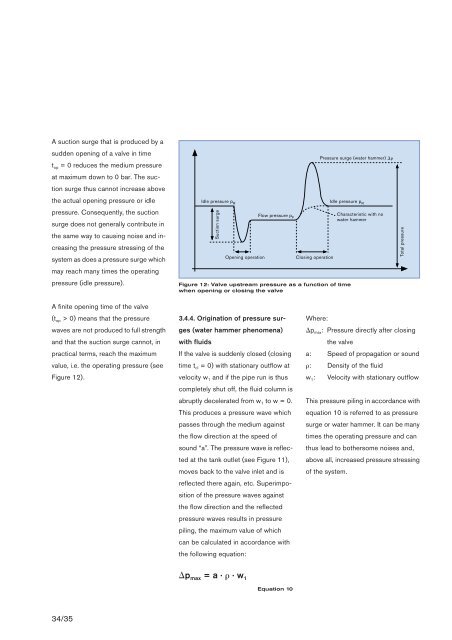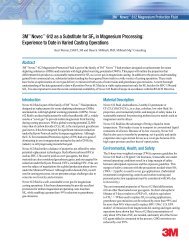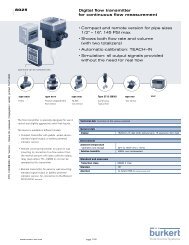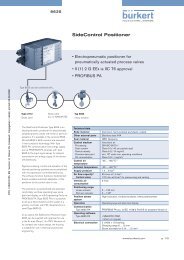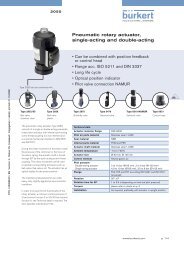Solenoid valves - Bürkert Fluid Control Systems
Solenoid valves - Bürkert Fluid Control Systems
Solenoid valves - Bürkert Fluid Control Systems
Create successful ePaper yourself
Turn your PDF publications into a flip-book with our unique Google optimized e-Paper software.
A suction surge that is produced by a<br />
sudden opening of a valve in time<br />
t op = 0 reduces the medium pressure<br />
at maximum down to 0 bar. The suction<br />
surge thus cannot increase above<br />
the actual opening pressure or idle<br />
pressure. Consequently, the suction<br />
surge does not generally contribute in<br />
the same way to causing noise and increasing<br />
the pressure stressing of the<br />
system as does a pressure surge which<br />
may reach many times the operating<br />
pressure (idle pressure).<br />
Idle pressure p R<br />
Suction surge<br />
Opening operation<br />
Flow pressure p F<br />
Closing operation<br />
Idle pressure p R<br />
Figure 12: Valve upstream pressure as a function of time<br />
when opening or closing the valve<br />
Pressure surge (water hammer) <br />
Characteristic with no<br />
water hammer<br />
Total pressure<br />
A finite opening time of the valve<br />
(t op > 0) means that the pressure<br />
waves are not produced to full strength<br />
and that the suction surge cannot, in<br />
practical terms, reach the maximum<br />
value, i.e. the operating pressure (see<br />
Figure 12).<br />
3.4.4. Origination of pressure surges<br />
(water hammer phenomena)<br />
with fluids<br />
If the valve is suddenly closed (closing<br />
time t cl = 0) with stationary outflow at<br />
velocity w 1 and if the pipe run is thus<br />
completely shut off, the fluid column is<br />
abruptly decelerated from w 1 to w = 0.<br />
This produces a pressure wave which<br />
passes through the medium against<br />
the flow direction at the speed of<br />
sound “a”. The pressure wave is reflected<br />
at the tank outlet (see Figure 11),<br />
moves back to the valve inlet and is<br />
reflected there again, etc. Superimposition<br />
of the pressure waves against<br />
the flow direction and the reflected<br />
pressure waves results in pressure<br />
piling, the maximum value of which<br />
can be calculated in accordance with<br />
the following equation:<br />
Where:<br />
p max : Pressure directly after closing<br />
the valve<br />
a: Speed of propagation or sound<br />
: Density of the fluid<br />
w 1 : Velocity with stationary outflow<br />
This pressure piling in accordance with<br />
equation 10 is referred to as pressure<br />
surge or water hammer. It can be many<br />
times the operating pressure and can<br />
thus lead to bothersome noises and,<br />
above all, increased pressure stressing<br />
of the system.<br />
p max = a · · w 1<br />
Equation 10<br />
34/35


